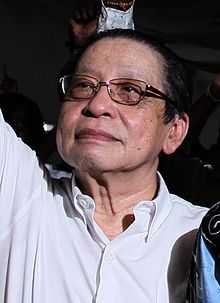Malaysian general election, 1978
| | |||||||||||||||||||||||||||||||||||||||||||||||||||||||||||||||
| |||||||||||||||||||||||||||||||||||||||||||||||||||||||||||||||
| |||||||||||||||||||||||||||||||||||||||||||||||||||||||||||||||
| |||||||||||||||||||||||||||||||||||||||||||||||||||||||||||||||
 |
| This article is part of a series on the politics and government of Malaysia |
|
|
|
|
Politics portal |
General elections were held in Malaysia on 8 July 1978.[1] It was Hussein Onn's first election since he became the country's third Prime Minister. His Barisan Nasional Party emerged victorious with 131 of the 154 seats in Parliament. Voter turnout was 75.3%.
Results
As expected, Barisan Nasional comfortably maintained its majority in the Malaysian Parliament and thus, gave the Prime Minister the power to form a government with a free hand. Despite the victory, BN actually lost four seats out of 154 seats to the opposition.
The Pan-Malaysian Islamic Party (PAS) withdrew from BN in the midst of the 1977 Kelantan Emergency over disagreements with UMNO over the running of the state government of Kelantan, which PAS had controlled since the first post-independence general election in 1959. With the support of UMNO, detractors within PAS split with the party and formed the Pan-Malaysian Islamic Front (BERJASA). In the election, PAS lost the control of the state for the first time to the UMNO-BERJASA alliance within BN. Tengku Razaleigh Hamzah has been credited for UMNO's victory in Kelantan.
The opposition garnered 42.8% of total votes. In spite of that, the opposition as one won only 23 seats. Democratic Action Party won the largest slice of the pie among the opposition parties and hence, its leader Lim Kit Siang retained his position as the leader of the opposition that he had obtained four years earlier.
Candidates were returned unopposed in nine constituencies. The registered electors from these constituencies therefore did not cast ballots.
Results
| Political Party | Votes | % of vote | Seats | % of seats | +/– | |||
|---|---|---|---|---|---|---|---|---|
| National Front | BN | 1,987,907 | 57.2 | 130 | 84.4 | -5 | ||
| United Malays National Organisation | UMNO | 69 | 44.8 | +7 | ||||
| Malaysian Chinese Association | MCA | 17 | 11.0 | -2 | ||||
| Malaysian People's Movement Party | Gerakan | 4 | 2.6 | -1 | ||||
| Malaysian Indian Congress | MIC | 3 | 1.9 | -1 | ||||
| People's Progressive Party | PPP | 0 | 0.0 | -1 | ||||
| Sabah People's United Front | BERJAYA | |||||||
| Sarawak National Party | SNAP | |||||||
| Sarawak United People's Party | SUPP | |||||||
| United Traditional Bumiputera Party | PBB | |||||||
| United Sabah National Organisation | USNO | |||||||
| Democratic Action Party | DAP | 664,433 | 19.1 | 16 | 10.4 | +7 | ||
| Pan-Malaysian Islamic Party | PAS | 537,720 | 15.5 | 5 | 3.2 | -8 | ||
| Sarawak People's Organisation | SAPO | 10,150 | 0.3 | 1 | 0.6 | New | ||
| Other parties | 112,850 | 3.2 | 0 | 0.0 | 0 | |||
| Independents | IND | 160,370 | 4.6 | 2 | 1.3 | +1 | ||
| Valid votes | 3,473,430 | |||||||
| Invalid/blank votes | 123,302 | |||||||
| Total (turnout: 75.3%) | 3,596,732 | 100.0 | 154 | 100.0 | 0 | |||
| Did not vote | 1,462,957 | |||||||
| Registered voters | 5,059,689 | |||||||
| Voting age population | 6,067,230 | |||||||
| Malaysian population | 12,303,000 | |||||||
| Source: Nohlen et al.
Candidates were returned unopposed in nine constituencies. The registered electors from these constituencies therefore did not cast ballots. | ||||||||
References
- ↑ Nohlen, D, Grotz, F & Hartmann, C (2001) Elections in Asia: A data handbook, Volume II, p152 ISBN 0-19-924959-8
| ||||||||||||||||||||||||||||||||||||||||||||||
.jpg)
